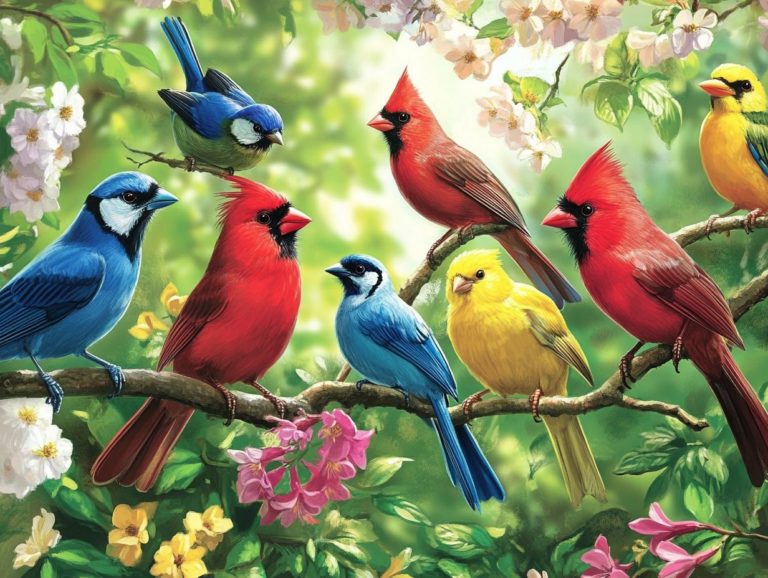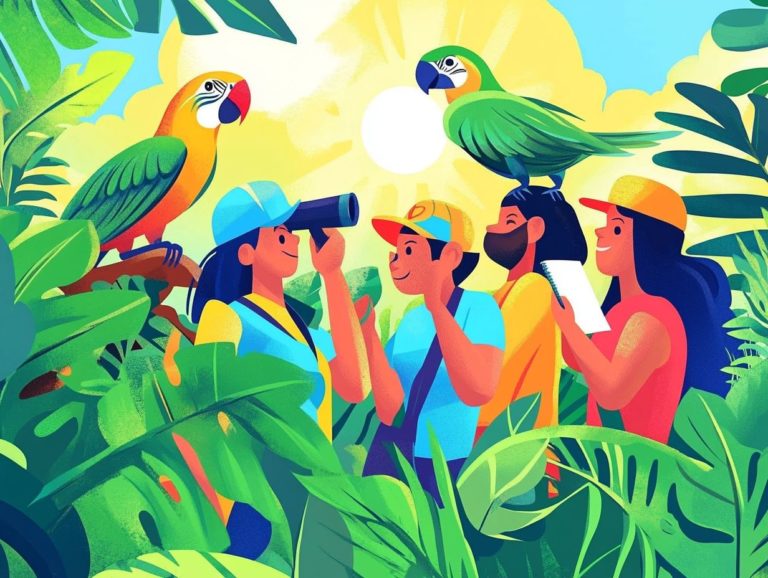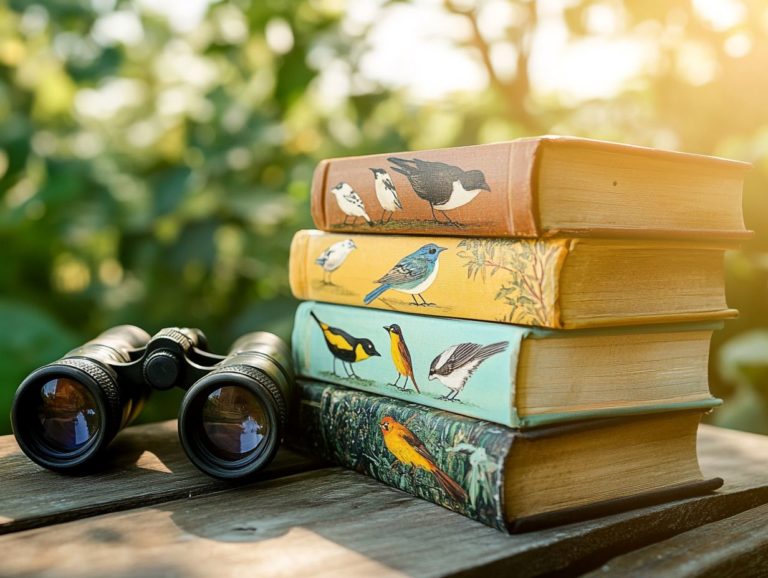What Are the Best Bird Watching Practices in National Parks?
Bird watching in national parks blends relaxation with adventure, making it an ideal activity for nature enthusiasts. These parks offer diverse ecosystems and a wealth of wildlife, providing perfect opportunities to observe birds in their natural habitats.
This guide covers the necessary preparations for bird watching in national parks, including essential gear, research, etiquette, and safety tips. The guide also outlines best practices for spotting and identifying birds, as well as documenting and sharing your experiences. It includes helpful tips for both experts and novices, aimed at enhancing the overall bird watching experience.
Contents
Key Takeaways:
- Research bird species and their habitats to enhance your birdwatching adventure.
- Respect wildlife and park rules to keep both birds and visitors safe.
- Improve your bird watching experience by learning how to identify bird calls and behaviors, and using binoculars and other tools for spotting and identifying birds.
Why National Parks are Ideal for Bird Watching
National parks are among the top spots for birdwatching and nature observation in the United States. Their diverse environments provide habitats for a wide variety of bird species.
For instance, Acadia National Park boasts a spectacular rocky coastline and various habitats that attract songbirds, seabirds, waterfowl, and raptors. It is renowned as one of the best locations for birdwatching in the US and is home to the critically endangered Atlantic Puffin.
Everglades National Park offers a unique subtropical ecosystem, sheltering endangered bird species such as the Florida Grasshopper Sparrow and the iconic Great Egret, which symbolizes the National Audubon Society and the American Bird Conservancy. Other notable parks, like Yellowstone National Park, feature stunning thermal landscapes and serve as habitats for the majestic American Bald Eagle and the graceful Sandhill Crane.
Olympic National Park, with its temperate rainforests and rugged Pacific beaches, attracts an extraordinary variety of birds, including the elusive marbled murrelet. Organizations such as the Audubon Society promote appreciation for these beautiful and essential bird species through birding events, educational programs, and advocacy for the conservation of their ecosystems.
For birdwatchers, tools like the Birda app enhance the experience by helping users identify species, track sightings, and share their experiences with an engaging community. Such resources make exploring the flora and fauna of national parks more accessible and enjoyable.
Preparing for Bird Watching in National Parks
When birdwatching in national parks, consider several factors that can enhance your experience. Key elements include having the right gear and learning about the various types of birds that inhabit these diverse environments.
You’ll want to grab key equipment like binoculars, field guides, and photography gear to make the most of your birdwatching adventure. These tools are particularly important during migration season when many species come to rest in these protected areas. Being well-prepared will maximize your chances of spotting unique birds and contribute to a more enjoyable birdwatching experience.
Essential Gear and Equipment
Birdwatching gear and equipment are essential for enhancing your experience in national parks, as they improve the chances of finding and identifying birds. Binoculars enable birdwatchers to observe distant birds in their natural habitats. Field guides provide valuable information about different species and their distinguishing features. Photography gear, such as a camera with a long lens, allows birdwatchers to capture the beauty of birds, which they can then share or cherish as personal memories.
When selecting binoculars, choose those that let you see clearly from a distance, preferably with an 8×42 configuration, which offers both power and light-gathering ability. This is particularly beneficial during early morning or late afternoon when birds are most active. A compact field guide featuring illustrations and written descriptions of local birds is also helpful for quickly confirming sightings, adding enjoyment and educational value to each birdwatching trip.
Using a DSLR or mirrorless camera equipped with a telephoto lens allows for stunning close-up shots of birds. This photographic gear encourages birdwatchers to gain a deeper understanding of bird behavior, as they learn to patiently wait for the perfect moment to capture a picture.
Researching Bird Species and Habitats
Researching bird species and their habitats is crucial for preparing a successful birdwatching trip to national parks. This knowledge helps you know where to look and what to expect during your visit.
Understanding the intricacies of local ecosystems provides insight into how factors like vegetation, local climate, and food availability influence which birds are attracted to a particular area. For instance, wetlands typically draw a wide variety of waterfowl. In contrast, dense forests can be home to songbirds that thrive in shaded environments.
Birdwatchers can benefit from various apps and websites. These platforms offer field guides, migration maps, and observations collected from other birdwatchers, which help improve planning.
Etiquette and Safety in National Parks
Knowing the right etiquette and safety rules makes your park visit enjoyable and protects wildlife.
Adhering to park etiquette, such as maintaining a safe distance from animals and staying on designated paths, helps safeguard the fragile habitats of various species, including birds. By practicing proper etiquette, you protect wildlife like the Virginia rail and Nene goose while enhancing the experience for fellow birdwatchers.
Respecting Wildlife and Park Rules
Respecting wildlife and adhering to park rules are essential components of responsible birdwatching in national parks. These practices help preserve natural habitats and ensure the safety of both visitors and animals. Birdwatchers should be aware that many species, such as the California quail and the golden eagle, are skittish and may alter their behavior if they feel threatened.
Park regulations often prohibit using playback calls near nesting sites. This helps prevent unnecessary stress on birds during their life cycles. Regardless of how tempting a sighting may be, staying on established paths protects fragile plant life and minimizes disturbances in sensitive habitats.
Using binoculars and scopes allows birdwatching enthusiasts to observe avian behavior without intruding. Such respectful practices ensure individual safety by reducing encounters with potentially dangerous species and play a crucial role in the long-term protection of local bird populations.
Staying Safe in the Outdoors
Ensuring safety while birdwatching in national parks requires careful planning and awareness of one’s surroundings. This minimizes potential dangers posed by wildlife and environmental factors.
When preparing for a safe and enjoyable experience, consider the terrain, weather conditions, and the behavior of larger wildlife such as bears and mountain lions. Carrying important safety supplies, like a first aid kit, and having a reliable means of communication are vital for being prepared for the unexpected during a birdwatching trip.
Stay alert for quick weather changes! A sudden rain or temperature drop can surprise even the most prepared birdwatchers. Dressing in layers and bringing waterproof outerwear can help ensure both safety and comfort.
Familiarizing yourself with local wildlife and their behaviors is crucial when traveling off-trail in unfamiliar areas. Knowing how to respond to an encounter can significantly impact safety. Sticking to well-marked paths and informing someone of your travel plans are basic yet effective measures to enhance the safety of a birdwatching excursion.
Best Practices for Spotting and Identifying Birds
Best practices for birdwatching can significantly enhance the overall experience, enabling enthusiasts to connect more deeply with nature and the remarkable avian life found in national parks.
Recognizing bird calls and behaviors are essential skills that increase the chances of spotting birds, particularly rare or elusive species that may blend into their surroundings. By employing various techniques such as careful observation and sound, and equipping themselves with the right tools, birdwatchers can improve their chances of encountering a diverse array of birds, including those migrating through the area.
Now, gear up and prepare for an amazing birdwatching adventure!
Identifying Bird Calls and Behaviors
Identifying bird calls and behaviors is an essential skill for any birdwatcher. These elements often serve as the first indicators of a bird’s presence before it is visually spotted.
For instance, the eerie call of the Common Loon or the melodious song of the American Robin not only makes birdwatching more enjoyable but also provides deeper insights into avian life. Learning to recognize these sounds fosters a greater appreciation for a bird’s role within its environment.
Mastering the techniques for identifying sounds and behaviors is quite achievable. Many field guides include descriptions of bird calls and photographs to aid in identification.
Various resources, such as dedicated apps and websites featuring sound libraries, can also help develop these skills. Enthusiasts can listen and practice at their own pace to familiarize themselves with the calls of local birds.
Learning is most effective within a community. Local birdwatching groups serve as invaluable resources, as experienced members often share their knowledge and tips for recognizing both calls and associated behaviors.
Using Binoculars and Other Tools
Binoculars and other tools enhance the birdwatching experience in national parks. They allow observers to see birds up close without disturbing their natural environments.
The right binocular magnification and lens quality enable birdwatchers to spot and identify species ranging from the California condor to the Virginia rail.
Field guides and mobile applications, such as Birda, provide instant access to identification information about various species and their habitats.
Features of binoculars, such as waterproofing, weight, and eye relief, significantly impact comfort, ensuring they are used effectively.
Understanding which features to prioritize helps birdwatchers select the right equipment for comfort and usability. Along with binoculars, region-specific field guides can enhance knowledge of local birds. Mobile apps offer opportunities to log sightings and share discoveries with fellow birdwatchers.
Together, these tools aid in identification and deepen the connection with nature.
Recording and Sharing Your Bird Watching Experience
Recording and sharing your birdwatching experiences is an exciting adventure! It documents your personal journey while contributing to broader conservation efforts and community engagement.
By taking photos, maintaining checklists of species observed, and sharing findings with organizations like the Audubon Society, you can actively engage in protecting avian populations and their habitats.
This practice cultivates a sense of community among nature enthusiasts and encourages exploration and discovery in national parks.
Taking Photos and Keeping a Checklist
The best practices for birdwatching include taking photographs and maintaining a checklist. These methods provide documentation of sightings and create personal records of species observed during birding trips.
Birdwatching photos can range from close-up shots showcasing the colorful feathers of a California quail to action shots capturing a California condor in flight. Keeping photographs allows birdwatchers to reflect on their experiences and fosters sharing and discussion with fellow enthusiasts.
A birdwatching checklist helps track different species and enhances understanding of the variety of birds inhabiting various environments.
The quality of birdwatching photos can be improved through technology, such as telephoto lenses—lenses that allow you to take close-up photos from a distance—and by applying good fieldcraft techniques.
This includes selecting appropriate times of day for optimal lighting when birds are most active and understanding the behavior and habitat of specific species.
Maintaining a checklist offers organizational benefits and aids in identifying the most common local birds while contributing to citizen science data collection.
Together, the practices of taking photos and keeping checklists enrich the birdwatching experience, blending artistic expression with scientific rigor and deepening appreciation for avian life.
Grab your binoculars and get started on your birdwatching adventure today!
Contributing to Citizen Science Projects
Engaging in citizen science projects offers a fun way to enjoy birdwatching while protecting nature. Organizations like the Audubon Society invite the public to help by collecting data on bird sightings and behaviors.
This data helps scientists gain deeper insights into bird populations. It also fosters a community of nature lovers dedicated to preserving wildlife’s beauty and diversity.
Join initiatives like the Great Backyard Bird Count or eBird to track changes in bird populations and sharpen your observation skills. This experience enhances your understanding of local ecosystems and builds a lasting commitment to protecting the environment.
Your participation contributes to essential research. Each sighting reported adds another piece to the puzzle, helping us learn how to coexist with and support our birds.
Frequently Asked Questions
What are the best birdwatching practices in National Parks?
Respect the birds and their habitat. Follow park rules and be considerate of other visitors.
What should I bring for birdwatching in National Parks?
- Binoculars
- A field guide
- A notebook and pen
- Appropriate clothing and footwear
How can I minimize my impact on the birds?
Avoid getting too close, making loud noises, or disturbing nests and habitats.
Are there rules for birdwatching in National Parks?
Yes, each park has its own set of rules. Research them beforehand to follow the guidelines.
Can I feed the birds while birdwatching?
No, feeding birds disrupts their natural behaviors and can harm their health.
What are some tips for successful birdwatching?
Be patient, stay quiet and still, and visit during early morning or late afternoon when birds are most active.




